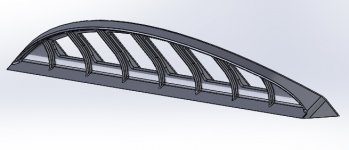ewlsey
Diamond
- Joined
- Jul 14, 2009
- Location
- Peoria, IL
I've been playing around in Solidworks with light weight straight edge designs. This design is 52" long, has a 3.5" wide sole, and weighs just 37.5 lbs.
I know I saw a picture of a sort of similar design once, but I can't recall the manufacturer. Basically, the whole arch is angled at 50 degrees to sneak under a dovetail. Then you can flip it over to scrap the other dovetail surface.
Based on the center of gravity, it should sit on the sole without tipping over backward. Quick and dirty FEA suggests .0001 deflection under it's own weight.
I'm not a pattern maker, but I did work in a foundry for several years. I think it can be cast. I thought I would run it by the local pattern shop to see what they thought.



I know I saw a picture of a sort of similar design once, but I can't recall the manufacturer. Basically, the whole arch is angled at 50 degrees to sneak under a dovetail. Then you can flip it over to scrap the other dovetail surface.
Based on the center of gravity, it should sit on the sole without tipping over backward. Quick and dirty FEA suggests .0001 deflection under it's own weight.
I'm not a pattern maker, but I did work in a foundry for several years. I think it can be cast. I thought I would run it by the local pattern shop to see what they thought.






